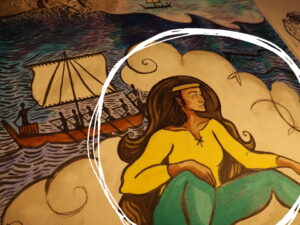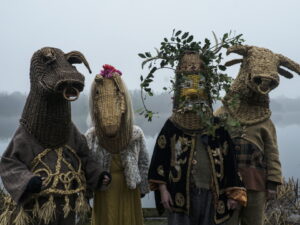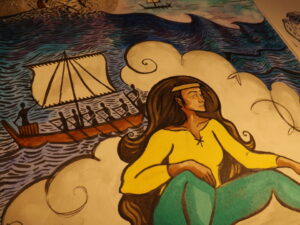
Folklore has long been a mainstay of Irish heritage and culture. Influencing music and literature; verse, song and language, the Celtic traditions of Paganism and myth percolate through the ages. Gael Linn, An tUltach and the Liverpool Irish Festival teamed up to create an artist commission to help explore some of Ireland’s stories.
The winner of the commission was Nuala Monaghan, an artist, illustrator and tour guide at Navan Fort (Armagh, Northern Ireland). Having pitched to contextualise the ‘life of the Iron Age Celt’ and bring ‘gods and goddesses to life’, her work was selected. We asked Nuala to speak about her process as well as how she approaches myth today.
Process
I grew up with a fascination for the myths and legends of Ireland. When I saw the opportunity to apply for the Liverpool Irish Festival commission, I knew that -whatever I was going to do- it was going to be about the magic of our mystic ancient history. Working in Navan Fort in Armagh, I know a fair bit about the Ulster Cycle of Tales; the myths and legends of the Cattle Raid of Cooley with Queen Maeve; King Conor MacNessa and Ulster’s champion, Cú Chulainn. However, I’m fascinated by the Cycle of Invasions; the arrival of the first peoples in Ireland and the old gods, the Tuath De Danann; the People of the Goddess Danu. It made sense to learn about the gods of old in order to understand the ways of life, of ancient people, here.
Exploration
Like all [my] projects, it started with a brainstorm. I quickly went down the rabbit hole of how the Tuath De Danann are still with us as ‘the fairy folk’. We never let go of our old gods, and most of us don’t realise it. They are visible in our superstitions, and even though the country exchanged Paganism for Christianity, we kept our Pagan tradition of Hallowe’en. So, in order to explore the idea of Hallowe’en more, I wanted to highlight the origins. I chose the stories then, about the first people in Ireland, introducing the gods, and revealing their downfall.
Testing
I had a go at making my own ink from indigenous plants; experimenting with blackberries, willow, and woad. The results weren’t great, but it was fun; drying and boiling leaves and crushing berries. I was particularly interested in the woad plant, which Celts used to make their blue war paint, but -again- it was not overly successful. It’s unbelievable how intelligent people were thousands of years ago; knowledge we take for granted today. Imagine having the knowledge you needed in your head, not on a phone or in a book! Imagine the sense of community [within] a people who learn from previous generations and by doing. This experimentation certainly got me into the headspace for the project.
Inspiration
After sketching out thumbnail ideas, and considering the symbolism I wanted to use, I took photos to work from and did more research. The skull is drawn from a photo of one that was found in a ritual pool near the King’s Stables (Armagh). Some of the faces are from sculptures I’d photographed on holidays, or items I’d seen in museums. It makes me think about how all these cultures came to Ireland over thousands of years and eventually developed into its own. I made lots of marks and textures I could collage together, digitally, and stuck with a purple and blue colour palette. This is a land of kings and queens after all; purple for royalty (as well as death) and blue: the colour of war.
Words cannot describe how grateful I am for the opportunity to highlight these aspects of our ancient heritage. We learn from stories and we enrich our lives with art. I have enjoyed every second of this project and learned a lot through it. I hope that sparks something in whoever sees it, too.
Contextualising myth today
Below, Nuala provides an overview of how Irish folklore has influenced modern day practices around the world, showing how myth sits within contemporary constructs.
It is a well-known fact that Hallowe’en originates from the ancient Celtic festival of Samhain. However, how often do we consider the incredulous survival of the tradition? With the tidal wave of Christianity that swept across Europe, this Pagan festival has somehow managed to remain with us after thousands of years, but do we really know why?
The answer is that those Pagan gods are still with us today; they are now known as the Fairies.
Samhain/Hallowe’en
At Hallowe’en we perform rituals to protect ourselves from evil spirits, as the veil between this world and ‘the Other’ is at its thinnest. We disguise ourselves that they might not recognise us and steal us away and celebrate the lives of those we have lost; telling stories, and reminding ourselves that we do not take the protection and guidance of our ancestors for granted.
When the people of Ireland exchanged Paganism for Christianity they never fully let go of Pagan traditions. Just like ancient tribes, accepting defeat after battle, they accepted that this new god -that came with new conquerors- must have been stronger than their own, but the respect for their own gods never died. The Pagan gods were demoted to Sainthood, or even cast out to fairydom as Christianity saw fit, but not even the Christian god could tear down the respect and fear the Pagan gods demanded. To this day, superstition reigns supreme, as even those who profess their distinct lack of faith in an afterlife will not touch a fairy tree, and leave the groves and forests of the fairy folk well alone.
This exhibition looks at some of the stories of the first peoples in Ireland, the gods that once resided here, what happened to them, and how they continue to coexist with modern ways of life in Ireland today.
See the storybook we made with Nuala, here.
Visit the exhibition page, here.
Gael Linn is a non-profit and non-governmental organisation focused on the promotion of the Irish language and the arts. An tUltach is Ireland’s oldesr Irish language literary magazine, established in 1924.
W: shorecollectiveni.com
F: @nualafmon
I: @nualafmon


